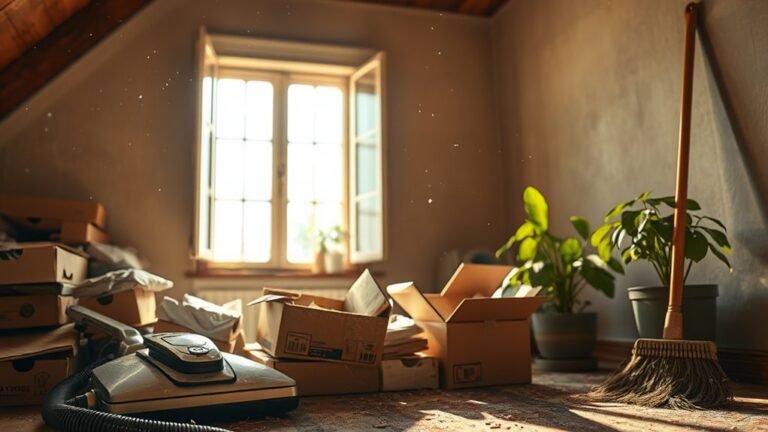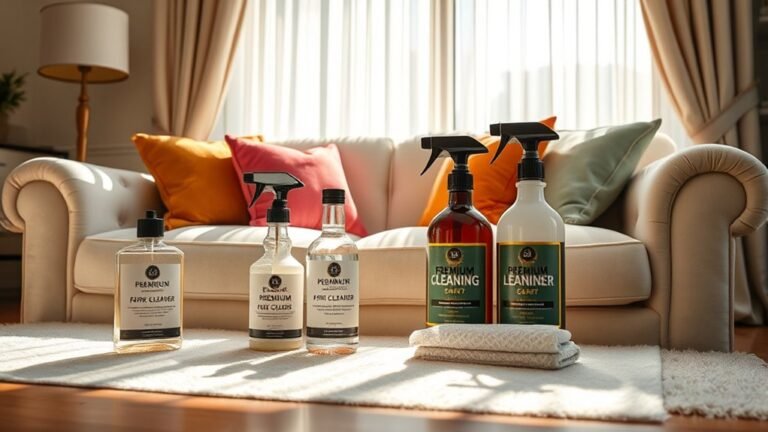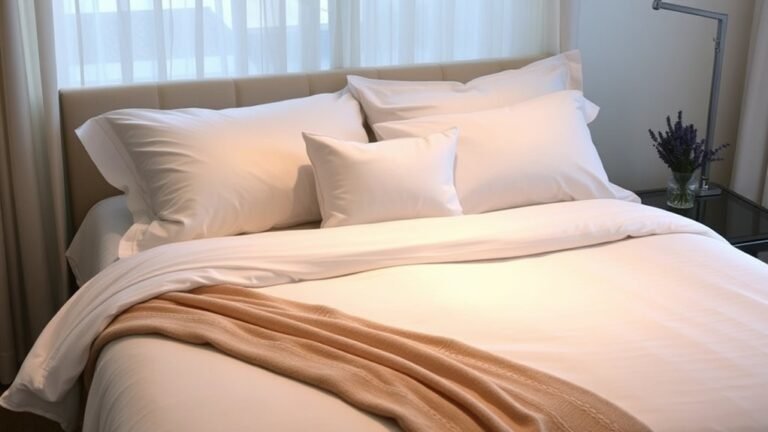How to Clean Baseboards
To clean your baseboards effectively, first gather a microfiber cloth, soft brush, and vacuum with brush attachment. Mix warm water, white vinegar, and liquid castile soap to create a natural cleaning solution. Start by removing dust with your cloth or vacuum set to low suction, then scrub baseboards gently using a damp sponge in long strokes. Address stubborn stains with mild soap or baking soda paste. Dry them promptly to avoid damage. Keep going for more tips on caring for painted and wood baseboards.
Gather Your Cleaning Supplies

Before you begin cleaning your baseboards, you’ll need to gather a few essential supplies to guarantee the job is efficient and thorough. Start with quality cleaning tools: a microfiber cloth, a soft-bristled brush, and a vacuum with a brush attachment. These will help you execute effective dusting techniques, capturing dirt without scratching surfaces. Prepare a bucket for your cleaning solution, but don’t mix it yet—this will come later. Have a sponge or a non-abrasive scrub pad on hand for stubborn grime. Gloves are advisable to protect your hands. Organizing these tools beforehand guarantees you move smoothly through the task, freeing you from interruptions. With these supplies ready, you’ll be set to clean your baseboards methodically and with precision, enjoying both freedom and control in the process.
Prepare the Cleaning Solution
With your cleaning supplies arranged and ready, the next step is to prepare the cleaning solution that will effectively tackle dirt and grime on your baseboards. Opt for natural cleaners to keep your space fresh and chemical-free. Here’s a precise method to get it right:
- Mix 1 cup of warm water with 1/4 cup of white vinegar for a gentle, effective cleaner.
- Add a few drops of liquid castile soap to boost cleaning power without harsh chemicals.
- Stir the mixture well to guarantee the solution ratios are balanced for peak performance.
- Pour the solution into a spray bottle for easy application and controlled use.
This tailored solution respects your freedom to clean smartly and safely.
Remove Loose Dust and Dirt

Anyone tackling baseboard cleaning should start by removing loose dust and dirt to guarantee the cleaning solution works effectively. Begin by selecting the right cleaning tools: a microfiber cloth, a soft-bristled brush, or a vacuum with a brush attachment. These tools efficiently lift dust without scratching surfaces. Use gentle, systematic dust removal techniques—work from top to bottom, making sure you cover every groove and edge. Pay close attention to corners where dirt collects. If you’re using a vacuum, set it to low suction to avoid damaging delicate paint. Taking this precise, methodical approach frees you from repeated cleanings and prepares the baseboards for thorough scrubbing. By mastering dust removal first, you make certain your cleaning effort is efficient and long-lasting, giving your home a fresh, polished look.
Scrub Baseboards With a Sponge or Cloth
Once you’ve cleared away the loose dust and dirt, it’s time to tackle the grime that’s stuck to your baseboards. Focus on sponge selection first: choose a soft, non-abrasive sponge or microfiber cloth to avoid damaging the finish. Then, follow these cleaning techniques:
After dusting, use a soft sponge or microfiber cloth to gently remove grime without harming your baseboards.
- Dampen your sponge or cloth with warm, soapy water—avoid soaking to prevent water damage.
- Gently scrub the baseboard in long, even strokes, following the grain or texture.
- Rinse your sponge frequently to avoid spreading dirt and grime back onto the surface.
- Wipe the baseboard with a clean, damp cloth to remove soap residue.
This methodical approach lets you clean effectively while preserving your baseboards’ integrity, giving you freedom from stubborn dirt without harsh scrubbing.
Tackle Stubborn Stains and Scuff Marks

When stubborn stains and scuff marks won’t budge with basic cleaning, you’ll need targeted methods to remove them effectively. Use gentle abrasives or specialized cleaners, applying them carefully to avoid damaging the baseboard finish. To keep your baseboards looking fresh, take steps that prevent future marks and wear.
Best Stain Removal Methods
Although baseboards often accumulate stubborn stains and scuff marks over time, you can effectively restore their appearance by using targeted stain removal methods. Understanding stain types lets you choose the right cleaning techniques. Here’s how to proceed:
- Identify the stain type: Determine if it’s grease, dirt, ink, or paint for tailored treatment.
- Use a gentle cleaner first: Mix mild dish soap with warm water and apply with a soft cloth to avoid damaging the finish.
- Try a baking soda paste: For tougher stains, combine baking soda and water, gently scrub, then rinse.
- Apply rubbing alcohol for ink or marker stains: Dab carefully on a cloth and test a small area before full application.
Effective Scuff Mark Solutions
If you want to remove scuff marks from your baseboards without causing damage, you’ll need to use specific tools and techniques designed for this purpose. Effective cleaning hinges on gentle abrasion and non-toxic solutions. Here’s a quick guide:
| Tool/Method | Application | Notes |
|---|---|---|
| Magic Eraser | Rub gently on marks | Avoid over-scrubbing |
| Baking Soda Paste | Apply, wait 5 min, wipe clean | Mild abrasive, safe for paint |
| Toothpaste (non-gel) | Apply and rub with cloth | Use soft cloth to prevent damage |
| Melamine Sponge | Lightly dampen, rub | Effective for stubborn stains |
| Vinegar Solution | Spray, wipe with cloth | Good for light scuff marks |
Using these tools guarantees scuff mark prevention with minimal effort, letting you maintain clean baseboards while preserving your freedom from harsh chemicals.
Preventing Future Baseboard Damage
Since baseboards often endure frequent contact and accidental bumps, preventing damage requires a proactive approach focused on both physical protection and regular maintenance. To guarantee lasting baseboard protection and minimize stubborn stains and scuff marks, follow these preventative measures:
- Install protective corner guards or bumpers in high-traffic areas to absorb impacts.
- Use washable paint finishes on baseboards for easier cleaning without damage.
- Regularly dust and wipe baseboards with a soft cloth to prevent grime buildup.
- Place furniture pads or felt protectors on chair and table legs to avoid scratching.
Dry and Buff the Baseboards
Grab a clean, dry microfiber cloth to carefully wipe down the baseboards, removing any remaining moisture from the cleaning process. Employ drying techniques that guarantee no water settles in crevices, which can cause damage over time. Work methodically along the length of each baseboard, applying gentle pressure to lift any lingering dampness. Once dry, select appropriate buffing materials—such as a soft polishing cloth or a gentle brush—to enhance the baseboard’s finish. Buff in smooth, even strokes, focusing on restoring the original sheen without causing abrasion. This precise approach not only improves appearance but also extends the life of your baseboards, giving you the freedom to enjoy a clean, protected environment without worry.
Maintain Clean Baseboards Regularly
Although deep cleaning is essential, maintaining clean baseboards regularly will prevent buildup and reduce the effort needed each time. Establishing a consistent cleaning schedule is key to effective baseboard maintenance. Here’s how you can stay on top of it:
- Inspect baseboards weekly for dust and dirt accumulation.
- Use a microfiber cloth or vacuum with a brush attachment to remove surface debris.
- Wipe down with a mild detergent solution every two weeks to address stains promptly.
- Dry thoroughly to avoid moisture damage.
Tips for Cleaning Painted vs. Wood Baseboards
Keeping your baseboards clean involves different approaches depending on their finish. For painted baseboard care, start by dusting with a microfiber cloth to avoid scratching the surface. Use a gentle, non-abrasive cleaner mixed with water, applying it with a soft sponge. Avoid soaking the paint to prevent peeling. Dry immediately with a clean cloth. With wood baseboard maintenance, dust regularly and use a wood-safe cleaner or a mixture of water and mild soap. Wipe along the grain to preserve the wood’s texture. After cleaning, apply a wood conditioner or polish to maintain luster and protect against drying. By tailoring your method to the baseboard type, you’ll keep them looking fresh and extend their lifespan without damaging the finish.
Frequently Asked Questions
Can I Use a Vacuum Cleaner to Clean Baseboards?
Yes, you can use a vacuum cleaner to clean baseboards effectively. You’ll want to attach the appropriate vacuum attachments, like a crevice tool or brush, to reach tight spaces and gently remove dust. Combining this with careful cleaning techniques—moving slowly to avoid damage—ensures thorough dirt removal. This method offers you freedom from harsh scrubbing while maintaining your baseboards’ appearance with minimal effort. Just remember to follow up with a damp cloth for stubborn spots.
How Often Should I Deep Clean My Baseboards?
Imagine your baseboards gleaming, free from dust and grime, adding charm to your space. For ideal cleaning frequency, deep clean every three to six months, depending on foot traffic and pet presence. Regular maintenance tips include wiping down monthly with a damp cloth to prevent buildup. Staying methodical with these intervals guarantees your baseboards always look fresh, giving you the freedom to enjoy a cleaner, more inviting home without constant hassle.
Are There Eco-Friendly Cleaning Solutions for Baseboards?
You can definitely use eco-friendly cleaning solutions for your baseboards by opting for homemade cleaners made with natural ingredients. Mix equal parts water and white vinegar, add a few drops of essential oil for scent, and use a soft cloth to gently wipe away dirt. This method is safe, effective, and lets you maintain a toxin-free home. By choosing natural ingredients, you control what touches your surfaces and keep your space fresh and clean.
Can Baseboards Be Cleaned With a Steam Cleaner?
Sure, steam cleaners provide spotless, swift solutions for baseboard maintenance. You’ll appreciate steam cleaner benefits like deep dirt dissolution without harsh chemicals, preserving your surfaces and promoting a healthier home. When using a steam cleaner, move methodically and maintain a moderate temperature to avoid damage. This approach lets you enjoy efficient, eco-friendly cleaning while safeguarding your baseboards, giving you freedom from grime and the hassle of traditional scrubbing.
What Should I Do if Paint Peels During Cleaning?
If paint peels during cleaning, first stop immediately to prevent more damage. You’ll want to gently sand the affected area to smooth rough edges. Then, use proper paint repair techniques: apply a primer suited for your baseboard material before repainting. Adjust your cleaning techniques to use gentler methods and avoid harsh chemicals that strip paint. This careful approach lets you maintain your baseboards’ look without sacrificing your freedom to clean effectively.






